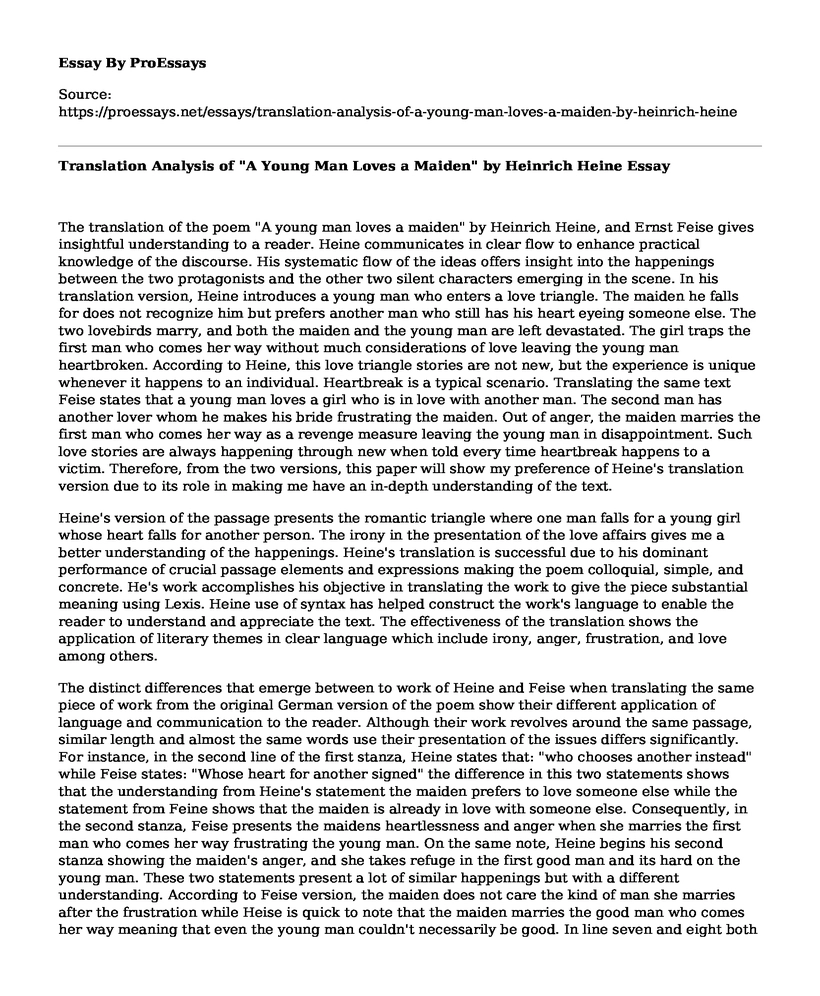The translation of the poem "A young man loves a maiden" by Heinrich Heine, and Ernst Feise gives insightful understanding to a reader. Heine communicates in clear flow to enhance practical knowledge of the discourse. His systematic flow of the ideas offers insight into the happenings between the two protagonists and the other two silent characters emerging in the scene. In his translation version, Heine introduces a young man who enters a love triangle. The maiden he falls for does not recognize him but prefers another man who still has his heart eyeing someone else. The two lovebirds marry, and both the maiden and the young man are left devastated. The girl traps the first man who comes her way without much considerations of love leaving the young man heartbroken. According to Heine, this love triangle stories are not new, but the experience is unique whenever it happens to an individual. Heartbreak is a typical scenario. Translating the same text Feise states that a young man loves a girl who is in love with another man. The second man has another lover whom he makes his bride frustrating the maiden. Out of anger, the maiden marries the first man who comes her way as a revenge measure leaving the young man in disappointment. Such love stories are always happening through new when told every time heartbreak happens to a victim. Therefore, from the two versions, this paper will show my preference of Heine's translation version due to its role in making me have an in-depth understanding of the text.
Heine's version of the passage presents the romantic triangle where one man falls for a young girl whose heart falls for another person. The irony in the presentation of the love affairs gives me a better understanding of the happenings. Heine's translation is successful due to his dominant performance of crucial passage elements and expressions making the poem colloquial, simple, and concrete. He's work accomplishes his objective in translating the work to give the piece substantial meaning using Lexis. Heine use of syntax has helped construct the work's language to enable the reader to understand and appreciate the text. The effectiveness of the translation shows the application of literary themes in clear language which include irony, anger, frustration, and love among others.
The distinct differences that emerge between to work of Heine and Feise when translating the same piece of work from the original German version of the poem show their different application of language and communication to the reader. Although their work revolves around the same passage, similar length and almost the same words use their presentation of the issues differs significantly. For instance, in the second line of the first stanza, Heine states that: "who chooses another instead" while Feise states: "Whose heart for another signed" the difference in this two statements shows that the understanding from Heine's statement the maiden prefers to love someone else while the statement from Feine shows that the maiden is already in love with someone else. Consequently, in the second stanza, Feise presents the maidens heartlessness and anger when she marries the first man who comes her way frustrating the young man. On the same note, Heine begins his second stanza showing the maiden's anger, and she takes refuge in the first good man and its hard on the young man. These two statements present a lot of similar happenings but with a different understanding. According to Feise version, the maiden does not care the kind of man she marries after the frustration while Heise is quick to note that the maiden marries the good man who comes her way meaning that even the young man couldn't necessarily be good. In line seven and eight both translations present a difference in how they present the story. According to Feise " it's an old story and yet its always new" while Heine states "It is so old a story yet somehow always new" The former shows the story has always had new meaning while the latter states that though the story was old, it sometimes has further implications.
(684 words)
Works cited
Heine, Heinrich. "A Young Man Loves a Maiden." Trans. Ernst Feise. The Norton Anthology of World Masterpieces. Vol 2. Ed. Maynard Mack. New York: W.W. Norton and Company. 1995.
Cite this page
Translation Analysis of "A Young Man Loves a Maiden" by Heinrich Heine. (2022, Apr 04). Retrieved from https://proessays.net/essays/translation-analysis-of-a-young-man-loves-a-maiden-by-heinrich-heine
If you are the original author of this essay and no longer wish to have it published on the ProEssays website, please click below to request its removal:
- Critical Essay Sample - The Tragedy of Othello
- Questions and Answers About Woman of Colour
- High School Should Start Later - Argumentative Essay
- Analysis of the Patriot Games Book Paper Example
- Araby by James Joyce Analysis Essay Example
- Definition Essay on Early Childhood Education
- Start Your Journey Now: Overcome Challenges With Determination - Essay Sample







